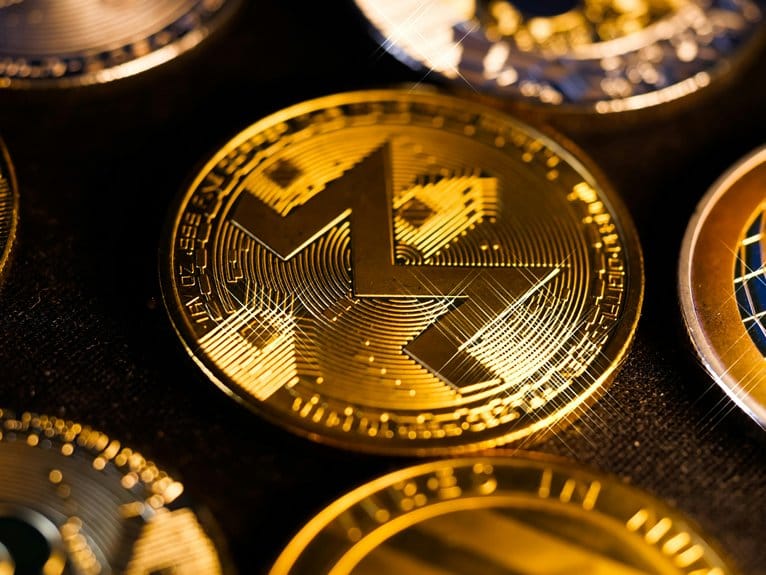Stablecoins are digital assets engineered to maintain price stability by pegging their value to external references like fiat currencies, commodities, or algorithmic mechanisms. The market has grown significantly, exceeding $100 billion in capitalization by 2023, with various types including fiat-backed (USDC, USDT), crypto-collateralized, and algorithmic models. These digital assets facilitate efficient cross-border transactions, reduce trading fees, and provide 24/7 market accessibility. While offering benefits like near-instantaneous settlements and inflation protection, stablecoins face challenges including regulatory oversight, security risks, and maintaining trust in reserve systems. Understanding these fundamentals becomes crucial as stablecoins continue reshaping global financial markets.
What Are Stablecoins
Nearly every cryptocurrency investor has encountered stablecoins – digital assets designed to maintain a stable value by pegging themselves to external reference points like fiat currencies, commodities, or algorithmic mechanisms.
These digital currencies aim to bridge the gap between traditional financial systems and the volatile crypto market by offering price stability in an otherwise fluctuating landscape.
The most common type of stablecoins are fiat-collateralized, typically backed 1:1 with reserve assets like USD. Market trends show increasing institutional adoption of stablecoins, with their total market capitalization exceeding $100 billion in 2023.
Other variants include crypto-collateralized stablecoins, which use cryptocurrency reserves, and algorithmic stablecoins, which maintain stability through smart contracts and supply adjustments.
Primary use cases for stablecoins include facilitating crypto trading, cross-border payments, and decentralized finance (DeFi) applications.
They serve as a reliable medium of exchange and store of value within the cryptocurrency ecosystem, enabling traders to quickly move between positions without converting to fiat currency.
Their growing integration into payment systems and financial services continues to expand their utility beyond traditional crypto markets.
Types of Stablecoins
Stablecoins can be categorized into four distinct types based on their collateralization mechanism: fiat-backed, crypto-collateralized, commodity-backed, and algorithmic stablecoins. Each type employs different collateralization methods to maintain its peg to the target asset, typically the US dollar.
Fiat-backed stablecoins, such as USDC and USDT, maintain a 1:1 reserve ratio with traditional currency holdings. These pegged assets represent the most straightforward and widely adopted implementation.
Crypto-backed stablecoins utilize over-collateralization of cryptocurrency assets, typically requiring 150% or more of the stablecoin's value in reserve, protecting against market volatility.
Commodity-backed stablecoins derive their value from physical assets like gold or silver, providing a hedge against both crypto and fiat currency fluctuations.
Algorithmic stablecoins represent the most complex variant, using smart contracts and mathematical formulas to maintain price stability without traditional collateral.
Some projects implement hybrid stablecoins, combining multiple approaches to enhance stability and reduce risks.
Decentralized stablecoins often emerge from these hybrid models, offering various use case scenarios while maintaining autonomous operation through smart contracts.
How Stablecoins Maintain Their Value
Maintaining a consistent value requires sophisticated mechanisms that vary according to each stablecoin's underlying collateralization model. The primary value stability mechanisms employed include over-collateralization, algorithmic adjustments, and real-time market arbitrage opportunities. These systems work in concert to maintain the target price peg, typically 1:1 with a fiat currency.
Fiat-collateralized stablecoins implement strict reserve management protocols, where each token is backed by traditional currency holdings in regulated financial institutions.
Crypto-collateralized versions utilize more complex collateralization strategies, often maintaining collateral ratios exceeding 150% to account for cryptocurrency volatility. Smart contracts automatically liquidate positions when collateral levels fall below predetermined thresholds.
Algorithmic stablecoins employ dynamic supply adjustments through programmatic burning and minting of tokens based on market demand. When the price exceeds the peg, the protocol increases supply; when it falls below, supply is reduced.
Market makers and arbitrageurs play a crucial role by exploiting price differentials across exchanges, effectively pushing the stablecoin's value back to its intended peg through their trading activities.
Benefits of Using Stablecoins
Anyone seeking to transact in the digital asset space can benefit from stablecoins' unique combination of cryptocurrency functionality and price stability.
These digital assets offer significant transaction efficiency through near-instantaneous settlements and reduced fees compared to traditional banking channels, particularly in cross border payments where costs can be cut by up to 70%.
Stablecoins provide enhanced market accessibility by enabling 24/7 trading and serving as a reliable on-ramp for cryptocurrency markets.
Their stable value proposition delivers effective risk mitigation for traders and investors who need to quickly move between volatile crypto positions and stable holdings.
For users in countries experiencing economic instability, stablecoins offer inflation protection by providing access to dollar-denominated assets without requiring traditional banking relationships.
From a liquidity management perspective, stablecoins enable businesses to optimize their treasury operations through programmable payments and automated financial processes.
Their blockchain-based infrastructure allows for transparent tracking of transactions, while smart contract functionality enables automated compliance and reporting.
This combination of features makes stablecoins particularly valuable for businesses operating across multiple jurisdictions or managing complex payment flows.
Risks and Potential Concerns
Despite their advantages, the stablecoin ecosystem faces several critical risks that warrant careful consideration by investors and users.
Market volatility remains a concern, particularly when collateral assets experience significant price fluctuations, potentially compromising the stablecoin's stability mechanism.
Security concerns persist due to smart contract vulnerabilities and potential cyber attacks on platforms handling these digital assets.
Regulatory challenges present another significant hurdle, as governments worldwide grapple with establishing comprehensive frameworks for stablecoin oversight.
The lack of standardized regulations creates uncertainty for both issuers and users, potentially impacting user adoption rates and market growth.
Technological risks, including blockchain network congestion and technical glitches in the underlying protocols, can affect transaction processing and overall system reliability.
Trust issues emerge when stablecoin issuers lack transparency regarding their reserve holdings or face difficulties maintaining their pegged value.
Historical incidents of stablecoin de-pegging have highlighted the importance of robust backing mechanisms and regular audits.
These factors collectively underscore the need for due diligence and risk assessment when engaging with stablecoin platforms, particularly as the ecosystem continues to evolve and mature.
Major Stablecoins in the Market
The stablecoin market is dominated by several key players that collectively represent over 90% of the total market capitalization in this sector.
Tether (USDT) maintains the largest market share despite ongoing transparency concerns and historical controversies regarding its reserve backing.
USD Coin (USDC), operated by Circle and Coinbase, has gained significant market adoption challenges by positioning itself as a more regulated alternative with regular audits.
DAI, created by MakerDAO, utilizes algorithmic stability mechanisms and has become popular in yield farming potential scenarios within decentralized finance.
BUSD, issued by Binance and Paxos, offers enhanced blockchain interoperability across various networks.
As central bank digital currencies emerge, these stablecoins face increasing scrutiny and competition from governmental institutions.
TerraUSD's collapse in 2022 highlighted critical user trust issues in algorithmic stablecoins, leading to increased demand for fully-backed alternatives.
This event reshaped the market landscape, pushing investors toward stablecoins with transparent reserve systems and regular attestations.
The sector continues to evolve as regulatory frameworks develop, with newer entrants focusing on compliance and technological innovation to address existing limitations.
Regulatory Landscape for Stablecoins
Regulatory oversight of stablecoins has intensified globally since 2021, with jurisdictions implementing varied approaches to supervision and control. Major financial regulators, including the Financial Stability Board (FSB) and Securities Exchange Commission (SEC), have highlighted the systemic risks posed by stablecoins to financial stability and monetary policy effectiveness.
The primary regulatory challenges center around reserve management, consumer protection, and anti-money laundering (AML) measures. In the United States, proposed legislation requires stablecoin issuers to maintain 100% reserves in high-quality liquid assets and undergo regular audits.
The European Union's Markets in Crypto-Assets (MiCA) regulation establishes comprehensive compliance frameworks specifically addressing stablecoin operations.
Asian jurisdictions have adopted diverse approaches, with Singapore implementing a licensing regime under the Payment Services Act, while China has banned stablecoin transactions entirely. Japan requires stablecoin issuers to register as licensed banks or trust companies.
These varying regulatory stances have created a complex global landscape where stablecoin operators must navigate multiple jurisdictional requirements, leading to increased operational costs and potential market fragmentation.
Industry participants are advocating for harmonized international standards to facilitate cross-border operations while maintaining stability and security.
Future of Stablecoin Technology
Emerging technological developments are poised to revolutionize stablecoin architecture over the next decade, with particular focus on scalability, interoperability, and novel stabilization mechanisms. Layer-2 scaling solutions and improved consensus algorithms are enabling stablecoin innovations that can process thousands of transactions per second while maintaining security and decentralization.
Cross-chain bridges and atomic swap protocols are advancing interoperability between different blockchain networks, allowing stablecoins to operate seamlessly across multiple platforms. This infrastructure development is crucial for future applications in global payments and decentralized finance.
Advanced smart contract implementations are introducing sophisticated stabilization methods, including algorithmic reserves and hybrid collateralization models. The integration of zero-knowledge proofs and privacy-preserving technologies is enhancing transaction confidentiality while maintaining regulatory compliance.
Machine learning algorithms are being deployed to optimize collateral management and predict market volatility. Industry analysts project that these technological improvements will expand stablecoin use cases beyond trading pairs into mainstream financial services, including automated market making, yield generation, and tokenized real-world assets.
The convergence of these innovations suggests stablecoins will become increasingly sophisticated financial instruments with enhanced utility and reliability.
Impact on Global Finance
Fundamentally reshaping international money flows, stablecoins are challenging traditional financial intermediaries by offering near-instant, low-cost cross-border transactions. The acceleration of stablecoin adoption has particularly impacted emerging markets, where traditional banking infrastructure remains limited.
Data shows that remittance services utilizing stablecoins can reduce transfer costs by up to 80% compared to conventional methods, while settlement times decrease from days to minutes.
Digital currency integration within existing financial systems has created new opportunities for financial inclusion, especially in regions with volatile local currencies. Studies indicate that stablecoins serve as effective inflation hedging tools in countries experiencing economic instability, with users maintaining purchasing power through dollar-pegged assets.
This trend has implications for monetary policy, as central banks must adapt to the growing influence of privately-issued digital currencies in their jurisdictions.
Investment diversification through stablecoins has also transformed institutional finance, with major financial institutions incorporating these assets into their treasury operations.
The market capitalization of leading stablecoins now exceeds $150 billion, demonstrating their significant role in global financial markets and cross-border capital flows.
Frequently Asked Questions
Can I Earn Interest by Holding Stablecoins in My Wallet?
Stablecoins can generate returns through various DeFi protocols offering interest rates and yield farming opportunities. Platforms typically offer APY ranging from 2-15%, depending on market conditions and risk levels.
What Happens to Stablecoins During a Blockchain Network Outage?
During blockchain network outages, stablecoin reliability depends on network risks. Transactions become temporarily inaccessible, but token values remain pegged. Once networks resume, normal operations and transfers continue automatically.
How Do I Convert My Stablecoins Back to Traditional Bank Money?
Convert stablecoins to fiat through regulated crypto exchanges, linking your bank account for direct withdrawals. Major platforms like Coinbase, Binance, and Kraken facilitate seamless stablecoin-to-fiat conversion with competitive rates.
Are Stablecoins Better for International Money Transfers Than Traditional Remittance Services?
Stablecoins offer significant advantages for international transfers, including near-instant transaction speed and lower fees compared to traditional remittance services, which typically take 3-5 days and charge 5-7% transaction fees.
Do I Need Specialized Hardware or Software to Store Stablecoins?
Stablecoins can be stored using various hardware options like cold wallets for maximum security, or software wallets for convenience. Popular choices include Ledger, Trezor, MetaMask, and Trust Wallet.
Conclusion
As stablecoins continue to evolve and integrate into mainstream financial systems, their role in facilitating digital transactions, cross-border payments, and DeFi applications becomes increasingly significant. The success of stablecoin adoption hinges on robust regulatory frameworks, technological innovation, and market stability. With growing institutional acceptance and technological advancements, stablecoins represent a crucial bridge between traditional finance and the digital asset ecosystem, potentially reshaping global financial infrastructure.





